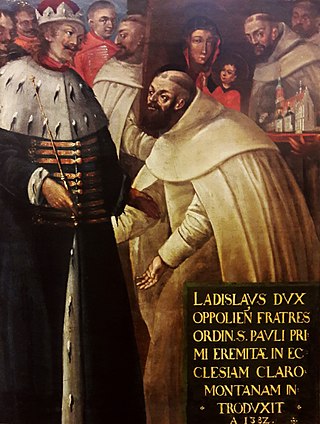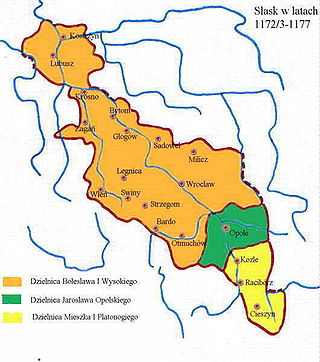
Opole Voivodeship, or Opole Province, is the smallest and least populated voivodeship (province) of Poland. The province's name derives from that of the region's capital and largest city, Opole. It is part of Upper Silesia. A relatively large German minority lives in the voivodeship, and the German language is co-official in 28 communes.

Opole is a city located in southern Poland on the Oder River and the historical capital of Upper Silesia. With a population of approximately 127,387 as of the 2021 census, it is the capital of Opole Voivodeship (province) and the seat of Opole County. Its built-up was home to 146,522 inhabitants. It is the largest city in its province.
The Duke of Silesia was the sons and descendants of the Polish Duke Bolesław III Wrymouth. In accordance with the last will and testament of Bolesław, upon his death his lands were divided into four or five hereditary provinces distributed among his sons, and a royal province of Kraków reserved for the eldest, who was to be High Duke of all Poland. This was known as the fragmentation of Poland. Subsequent developments lead to further splintering of the duchies.

Opole Lubelskie is a town in southeastern Poland. As of 2004, it had 8,879 inhabitants. The town is situated in Lublin Voivodeship, some 10 kilometers east of the Vistula River, and is the capital of Opole Lubelskie County. It was founded in the 14th century, and historically belongs to Lublin Land, which is part of Lesser Poland.

Opole University of Technology is a university located in Opole, Poland.

Opole County is a unit of territorial administration and local government (powiat) in Lublin Voivodeship, eastern Poland. It was established on January 1, 1999, as a result of the Polish local government reforms passed in 1998. Its administrative seat is the town of Opole Lubelskie, which lies 44 kilometres (27 mi) west of the regional capital Lublin. The only other town in the county is Poniatowa, lying 8 km (5 mi) north-east of Opole Lubelskie.

Vladislaus II of Opole, nicknamed Naderspan, was Duke of Opole from 1356, Count palatine of Hungary (1367–1372), Duke of Wieluń (1370–1392), Governor of Ruthenia (1372–1378), Count palatine of Poland (1378) as well as Duke of Dobrzyń, Inowrocław (1378–1392), Krnov and Kuyavia (1385–1392).

Nysa County is a unit of territorial administration and local government (powiat) in Opole Voivodeship, south-western Poland, on the Czech border. It came into being on January 1, 1999, as a result of the Polish local government reforms passed in 1998. Its administrative seat and largest town is Nysa, which lies 48 kilometres (30 mi) south-west of the regional capital Opole. The county contains four other towns: Głuchołazy, 18 km (11 mi) south of Nysa, Paczków, 24 km (15 mi) west of Nysa, Otmuchów, 12 km (7 mi) west of Nysa, and Korfantów, 20 km (12 mi) east of Nysa.

Opole County is a unit of territorial administration and local government (powiat) in Opole Voivodeship, south-western Poland. It came into being on January 1, 1999, as a result of the Polish local government reforms passed in 1998. Its administrative seat is the city of Opole, although the city is not part of the county. The county contains four towns: Ozimek, 20 km (12 mi) east of Opole, Niemodlin, 24 km (15 mi) west of Opole, Prószków, 11 km (7 mi) south-west of Opole, and Tułowice, 22 kilometres (14 mi) south-west of Opole.

OKS Odra Opole is a football club based in Opole, Poland, currently playing in the I liga.

The National Festival of Polish Song in Opole is an annual music festival in Opole, Poland. Together with the Sopot Festival it is one of the two most important music festivals in Poland.

The University of Opole is a public university in the city of Opole. It was founded in 1994 from a merger of two parallel educational institutions. The university has 17,500 students completing 32 academic majors and 53 specializations. The staff numbers 1,380 - among them are 203 professors and habilitated doctors and 327 doctors.

Duchy of Racibórz was one of the duchies of Silesia. Its capital was Racibórz in Upper Silesia.

Duchy of Opole was one of the duchies of Silesia ruled by the branch of Polish Piast dynasty. Its capital was Opole in Upper Silesia.

Opolans were the West Slavic tribe that lived in the region of upper Odra. Their main settlement (gord) was Opole. They were mentioned in the Bavarian Geographer, under the Latin name Opolini, as one of the seven tribes living in Silesia. The other six were: Dziadoszanie, Golęszyce, Ślężanie, Trzebowianie, Bobrzanie and Lupiglaa.

The Duchy of Opole and Racibórz was one of the numerous Duchies of Silesia ruled by the Silesian branch of the royal Polish Piast dynasty. It was formed in 1202 from the union of the Upper Silesian duchies of Opole and the Racibórz, in a rare exception to the continuing feudal fragmentation of the original Duchy of Silesia.

The coat of arms of Lower Silesia, and simultaneously of Silesia, shows a black eagle with silver crescent with cross in the middle on its chest on a golden background. It has been assumed in the tradition that the coat of arms and colors of Lower Silesia are simultaneously used as symbols of Silesia as a whole.

The coat of arms, that serves as the symbol of the Opole Voivodeship, Poland, features a yellow (golden) eagle wearing a yellow (golden) crown, placed on a blue background. It was adopted in 2001.
Kolejarz Opole is a motorcycle speedway team based in Opole, Poland. They currently race in the Polish Speedway Second League.
















